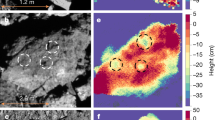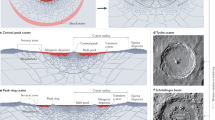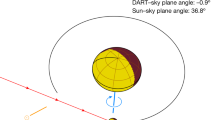Abstract
Earth is continuously colliding with fragments of asteroids and comets of various sizes. The largest encounter in historical times occurred over the Tunguska river in Siberia in 1908, producing1,2 an airburst of energy equivalent to 5–15 megatons of trinitrotoluene (1 kiloton of trinitrotoluene represents an energy of 4.185 × 1012 joules). Until recently, the next most energetic airburst events occurred over Indonesia3 in 2009 and near the Marshall Islands4 in 1994, both with energies of several tens of kilotons. Here we report an analysis of selected video records of the Chelyabinsk superbolide5 of 15 February 2013, with energy equivalent to 500 kilotons of trinitrotoluene, and details of its atmospheric passage. We found that its orbit was similar to the orbit of the two-kilometre-diameter asteroid 86039 (1999 NC43), to a degree of statistical significance sufficient to suggest that the two were once part of the same object. The bulk strength—the ability to resist breakage—of the Chelyabinsk asteroid, of about one megapascal, was similar to that of smaller meteoroids6 and corresponds to a heavily fractured single stone. The asteroid broke into small pieces between the altitudes of 45 and 30 kilometres, preventing more-serious damage on the ground. The total mass of surviving fragments larger than 100 grams was lower than expected7.
This is a preview of subscription content, access via your institution
Access options
Subscribe to this journal
Receive 51 print issues and online access
$199.00 per year
only $3.90 per issue
Buy this article
- Purchase on Springer Link
- Instant access to full article PDF
Prices may be subject to local taxes which are calculated during checkout

Similar content being viewed by others
References
Vasilyev, N. V. The Tunguska meteorite problem today. Planet. Space Sci. 46, 129–150 (1998)
Boslough, M. B. E. & Crawford, D. A. Low altitude airbursts and the impact threat. Int. J. Impact Eng. 35, 1441–1448 (2008)
Silber, E. A., Le Pichon, A. & Brown, P. G. Infrasonic detection of a near-Earth object impact over Indonesia on 8 October 2009. Geophys. Res. Lett. 38, L12201 (2011)
McCord, T. B. et al. Detection of a meteoroid entry into the Earth’s atmosphere on February 1, 1994. J. Geophys. Res. 100 (E2). 3245–3249 (1995)
Brown, P. G. et al. A 500-kiloton airburst over Chelyabinsk and an enhanced hazard from small impactors. Nature http://dx.doi.org/10.1038/nature12741 (this issue)
Popova, O. et al. Very low strengths of interplanetary meteoroids and small asteroids. Meteorit. Planet. Sci. 46, 1525–1550 (2011)
Bland, P. A. & Artiemeva, N. A. Efficient disruption of small asteroids by Earth’s atmosphere. Nature 424, 288–291 (2003)
Jenniskens, P. et al. Radar-enabled recovery of the Sutter’s Mill meteorite, a carbonaceous chondrites regolith breccia. Science 338, 1583–1587 (2012)
Borovička, J., Popova, O. P., Nemtchinov, I. V., Spurný, P. & Ceplecha, Z. Bolides produced by impacts of large meteoroids into the Earth’s atmosphere: comparison of theory with observations. I. Benešov bolide dynamics and fragmentation. Astron. Astrophys. 334, 713–728 (1998)
Borovička, J. & Kalenda, P. The Morávka meteorite fall: 4. Meteoroid dynamics and fragmentation in the atmosphere. Meteorit. Planet. Sci. 38, 1023–1043 (2003)
Borovička, J. et al. The Košice meteorite fall: atmospheric trajectory, fragmentation, and orbit. Meteorit. Planet. Sci. http://dx.doi.org/10.1111/maps.12078 (17 April 2013)
Spurný, P. et al. The Bunburra Rockhole meteorite fall in SW Australia: fireball trajectory, luminosity, dynamics, orbit, and impact position from photographic and photoelectric records. Meteorit. Planet. Sci. 47, 163–185 (2012)
Nazarov, M. A. Chelyabinsk. Meteorit. Bull. 102, (2013)
Borovička, J. The comparison of two methods of determining meteor trajectories from photographs. Bull. Astron. Inst. Czechoslovakia 41, 391–396 (1990)
Delbó, M., Harris, A. W., Binzel, R. P., Pravec, P. & Davies, J. K. Keck observations of near-Earth asteroids in the thermal infrared. Icarus 166, 116–130 (2003)
Binzel, R. P. et al. Observed spectral properties of near-Earth objects: results for population distribution, source regions, and space weathering processes. Icarus 170, 259–294 (2004)
Southworth, R. B. & Hawkins, G. S. Statistics of meteor streams. Smithsonian Contrib. Astrophys. 7, 261–285 (1963)
Drummond, J. D. A test of comet and meteor shower associations. Icarus 45, 545–553 (1981)
Mainzer, A. et al. NEOWISE observations of near-Earth objects: preliminary results. Astrophys J. 743, 156 (2011)
Bottke, W. F., Jr et al. Debiased orbital and absolute magnitude distribution of the near-Earth objects. Icarus 156, 399–433 (2002)
Artemieva, N. A. & Shuvalov, V. V. Motion of fragmented meteoroid through the planetary atmosphere. J. Geophys. Res. 106 (E2). 3297–3309 (2001)
Park, C. & Brown, J. D. Fragmentation and spreading of a meteor-like object. Astron. J. 144, 184 (2012)
Brown, P. et al. Analysis of a crater-forming meteorite impact in Peru. J. Geophys. Res. 113, E09007 (2008)
Borovička, J. & Spurný, P. The Carancas meteorite impact: encounter with a monolithic meteoroid. Astron. Astrophys. 485, L1–L4 (2008)
Daubar, I. J., McEwen, A. S., Byrne, S., Kennedy, M. R. & Ivanov, B. The current Martian cratering rate. Icarus 225, 506–516 (2013)
Kelley, M. C., Williamson, C. H. K. & Vlasov, M. N. Double laminar and turbulent meteor trails observed in space and simulated in the laboratory. J. Geophys. Res. 118, 3622–3625 (2013)
Sánchez, P. & Scheeres, D. J. The strength of regolith and rubble pile asteroids. Preprint at http://arxiv.org/abs/1306.1622 (2013)
Everhart, E. in Dynamics of Comets: Their Origin and Evolution (eds Carusi, A. & Valsecchi, G. ) 185 (Kluwer, 1985)
Clark, D. & Wiegert, P. A numerical comparison with the Ceplecha analytical meteoroid orbit determination method. Meteorit. Planet. Sci. 46, 1217–1225 (2011)
Ceplecha, Z. Geometric, dynamic, orbital and photometric data on meteoroids from photographic fireball networks. Bull. Astron. Inst. Czechoslovakia 38, 222–234 (1987)
Acknowledgements
We thank D. Částek and O. Popova and her team (V. Emelyanenko, A. Kartashova, D. Glazachev and E. Biryukov) for providing the nocturnal in situ calibration images. We are obliged to all the videographers who posted videos of the Chelyabinsk superbolide on the internet. The work of J.B., P.S. and L.S. was supported by grant no. P209/11/1382 from GAČR and Praemium Academiae. The Czech institutional project was RVO:67985815. The work of P.B., P.W. and D.C. was supported in part by the Natural Sciences and Engineering Research Council of Canada and NASA’s Meteoroid Environment Office.
Author information
Authors and Affiliations
Contributions
J.B. made measurements from most of the videos, computed the bolide trajectory and velocity, and analysed its atmospheric fragmentation and dust trail. P.S. organized the calibrations, made measurements from the calibration images and participated in interpreting the results. P.B. participated in the acoustic analysis and in interpreting the results. P.W. and D.C. performed the orbital integration, analysed the parent-body linkage and analysed the asteroid visibility before impact. P.K. found many important videos and participated in the acoustic analysis. L.S. prepared the calibrations and participated in video measurements. All authors commented on the manuscript.
Corresponding author
Ethics declarations
Competing interests
The authors declare no competing financial interests.
Extended data figures and tables
Extended Data Figure 1 Visibility and orbital evolution of Chelyabinsk asteroid in the past.
The results of backward integration of Chelyabinsk nominal orbit (red) and its 1,000 clones (black dots). a, Apparent magnitude as seen from the Earth at 30-day intervals during past 10 years. Green, mean of all clones. Plotted only for elongations >45° from the Sun. b, Minimum orbit intersection distance (MOID) between the Chelyabinsk orbit and the osculating orbit of asteroid 86039 during the past 2,000 years. c, Change in velocity required to reach Chelyabinsk orbit from the orbit of 86039 at MOID during the past 2,000 years.
Extended Data Figure 2 Light curve of Chelyabinsk superbolide in relative units and fragmentation altitudes as determined from sonic booms.
The luminous signal was computed in relative units from pixel sum values from substantial parts of the images, and then normalized to 100. Corrections to bolide range and atmospheric extinction were applied but no attempt to convert the signal to absolute units was made (for the absolute light curve, see ref. 5). For each video, the measured pixel sum was corrected using the estimated changes of automatic gain control of the camera. The absolute timing was obtained from the Nizhny Tagil video (L1) and the height scale from the Beloreck video (video 14, or L4). The fragmentation altitudes were determined from the timing of secondary sonic booms and numerical ray-tracing modelling of the sonic wave’s propagation from the bolide to the video sites. The videos used are listed in Extended Data Table 1. a, Bolide light curve as a function of time. b, The same data as a function of height compared with the computed source heights of sonic booms detected (as image failures) in the Mirnyi video (A19). The fragmentations are marked by vertical bars at the corresponding height. The length of the bar is proportional to the number of video frames affected by the failure. c, The compilation of sonic boom source heights from all 19 videos used for acoustic analysis.
Extended Data Figure 3 Deviation of fragment F1 from the main trajectory.
Frame from video 15. The time is counted from 3:20:20 ut. The labelled marks identify points on the main trajectory at the given altitude (in kilometres). E represents the endpoint of the main trajectory.
Extended Data Figure 4 Predicted impact position of fragment F1, computed with four different wind fields, compared with the position of the hole in the ice (‘Crater’).
The point marked F1 was computed with Verkhnee Dubrovo radiosonde data (0:00 ut). Point K is for Kurgan radiosonde (0:00 ut), point U is for the UKMO wind model for Chelyabinsk (12:00 ut) and point G is for the G2S model (3:00 ut) (ref. 31 in Supplementary Information). The distance between U and K is 960 m. The distance between F1 and the crater is 220 m. We note that the position of the crater was not used for the computation of the F1 trajectory and impact point. The background image is from Google Earth and was taken one day after the impact.
Extended Data Figure 5 Identification of fragments in a series of images from video 7.
Fragments F1–F7 originated at lower altitudes (∼25 km), whereas fragments F11–F16 originated at higher altitudes (>30 km).
Extended Data Figure 6 Dynamics of the dust trail and fragments and predicted impact positions of observed fragments.
a, Altitude as a function of time for the lower edge of the thick dust trail (TE) and hotspots within the trail (HS1–HS3). The hotspots are identified in Extended Data Fig. 7. b, Altitude as a function of time for the main body (M), lower fragments (F1–F7) and upper fragments (F11–F16), plotted together with the dust trail features. The fragments are identified in Extended Data Fig. 5. The main body and trail were measured primarily from video 2; and the fragments, from video 7. c, Upward motion of the main hotspot (HS1) within the dust trail. Vertical deviation of the centre of the hotspot from the trajectory is plotted against time. The linear fit gives upward velocity of 0.08 km s−1. d, Predicted impact positions and dynamic properties of observed fragments. Ablation coefficients and terminal masses were obtained by fitting the observed decelerations. Masses are valid for assumed spherical shapes and bulk densities of 3,300 kg m−3. In some cases, the ablation coefficient could not be computed because there was an insufficient number of data points.
Extended Data Figure 7 Images of the dust trail at early stages.
a–c, Images from a single video site (video 2) located north of the fireball trajectory. Time is counted from 3:20:20 ut. Three distinct hotspots (HS1–HS3) are identified. The labelled marks identify points on the trajectory at the given altitude (in kilometres). The unlabelled marks above them identify points at the same geographic coordinates but 1 km higher. They are provided to assess the width of the trail. d, Image from video 14, from the southwest. It demonstrates that the width of the fully illuminated fresh trail was ∼2 km over much of its length. For later evolution of the trail, see Extended Data Figs 8 and 9.
Extended Data Figure 8 Evolution of the lower part of the dust trail as seen from Chelyabinsk during the first minute.
Three frames from video 6 (the video has colour defects). The time is given in minutes and seconds and is counted from 3:20:20 ut. The lower marks identify points on the trajectory in 1-km altitude intervals. The upper marks identify points at the same geographic coordinates but 1 km higher. The video demonstrates vertical ascent and splitting of the trail. When the original video is speeded up, rotation of the material in the trail is clearly visible. The trail was illuminated from below. The ‘bubble’ formed at the position of the main hotspot (HS1; see Extended Data Fig. 7) was in shadow most of the time. Only its illuminated top is visible on the third frame, just at the edge of the field of view.
Extended Data Figure 9 Longer-term evolution of the dust trail.
Five frames from an uncalibrated video (http://www.youtube.com/watch?v=Z20lnOVscpc, author D. Beletsky) taken from south of the fireball trajectory (on the road from Magnitogorsk to Chelyabinsk). The time is given in minutes and seconds and is counted from 3:20:20 ut. The trail was fully illuminated from this site. The video demonstrates the rise of the ‘bubble’ formed at the position of the main hotspot (HS1; see Extended Data Fig. 7). The maximum altitude was reached about 3 min after the bolide had passed by.
Supplementary information
Supplementary information
This file contains Supplementary Text and Data 1-9 and additional references. (PDF 283 kb)
PowerPoint slides
Rights and permissions
About this article
Cite this article
Borovička, J., Spurný, P., Brown, P. et al. The trajectory, structure and origin of the Chelyabinsk asteroidal impactor. Nature 503, 235–237 (2013). https://doi.org/10.1038/nature12671
Received:
Accepted:
Published:
Issue Date:
DOI: https://doi.org/10.1038/nature12671
This article is cited by
-
New meteoroid entry method with a deformable non-spherical N-body model
Acta Mechanica Sinica (2024)
-
Aggregate effects of proliferating low-Earth-orbit objects and implications for astronomical data lost in the noise
Nature Astronomy (2023)
-
The Mechanical Properties of Chelyabinsk LL5 Chondrite Under Compression and Tension
Earth, Moon, and Planets (2021)
Comments
By submitting a comment you agree to abide by our Terms and Community Guidelines. If you find something abusive or that does not comply with our terms or guidelines please flag it as inappropriate.



